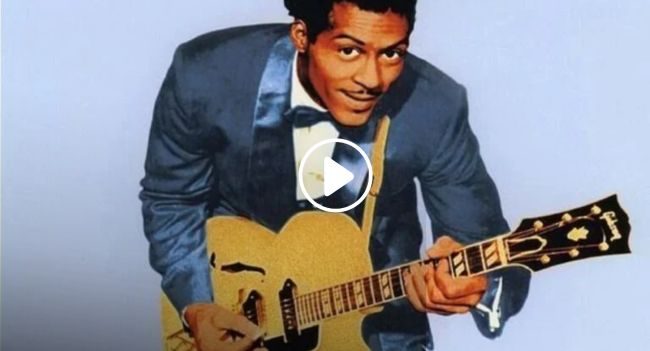Chuck had his finger on the musical pulse of the times. The industry hasn’t been the same since this song.
In the pantheon of rock ‘n’ roll, few songs have etched their mark as deeply as Chuck Berry’s “Johnny B. Goode.”
Born from a blend of rhythm, blues, and a storyteller’s heart, this track didn’t just chart a path through the music of the 1950s.
It became a lightning rod for aspiring musicians everywhere.
Its roots, deeply entangled with Berry’s own experiences, reflect a narrative of ambition, talent, and the dream of rising to stardom against all odds.

Crafted by Berry in 1955, “Johnny B. Goode” spins the tale of a semi-literate “country boy” from near New Orleans, whose guitar prowess was as compelling as “ringing a bell.”
Berry, in a nod to his own journey, initially painted Johnny as a “colored boy” but shifted to “country boy” for broader radio appeal.
Intriguingly, the song’s title and narrative also wink at Berry’s personal history, considering he hailed from 2520 Goode Avenue in St. Louis.

The genesis of “Johnny B. Goode” was inspired by Johnnie Johnson, Berry’s band’s stalwart pianist, though it ultimately evolved into a more personal anthem.
The recording session itself was a collaboration of talents, including Lafayette Leake on piano, Willie Dixon on bass, and Fred Below on drums, all orchestrated by the legendary Chess brothers, Leonard and Phil.

The song’s iconic opening riff, an homage to the sounds of Louis Jordan’s “Ain’t That Just Like a Woman,” exemplifies Berry’s genius in blending inspirations to create something uniquely his.
Keith Richards observed that the song’s chord progressions were more akin to piano compositions.

“Johnny B. Goode” rocketed Berry to fame.
It also became a staple of rock ‘n’ roll, earning its place in history when Berry performed it at the first Rock and Roll Hall of Fame induction ceremony in 1986.
He was backed by none other than Bruce Springsteen and the E Street Band.
It’s a song that has resonated through the ages, recognized by the Grammy Hall of Fame and the Rock and Roll Hall of Fame as a cornerstone of the genre.
The song’s influence spans genres and generations, covered by artists from Buck Owens to Jimi Hendrix, Peter Tosh to Judas Priest, and even the punk energy of the Sex Pistols.
Its versatility and appeal are a testament to Berry’s groundbreaking impact on music and culture.
Beyond its sonic legacy, “Johnny B. Goode” ventured into space as part of the Voyager Golden Record, a testament to its universal appeal.
It also leaped onto the silver screen in “Back to the Future,” where Michael J. Fox’s Marty McFly channels Berry’s spirit in a performance that blurs the lines between past and future, fact and fiction.
The song’s legacy is further immortalized by Devo’s tribute, “Come Back Jonee,” showcasing how Berry’s influence pervaded not just rock ‘n’ roll but also the realms of punk and new wave.
“Johnny B. Goode” stands as a cultural touchstone, bridging divides and inspiring countless artists to embrace their quirks and talents.

As we prepare to watch a video of “Johnny B. Goode,” it’s not just about revisiting a classic tune.
It’s about celebrating the enduring spirit of rock ‘n’ roll, the stories of those who dare to dream big, and the magical, unifying power of music.
Chuck Berry’s masterpiece invites us to experience again the joy, rebellion, and innovation that “Johnny B. Goode” embodies—a timeless journey into the heart of rock history.
Hear the iconic song that shot Chuck Berry to fame in the video below!
Please SHARE this with your friends and family.
